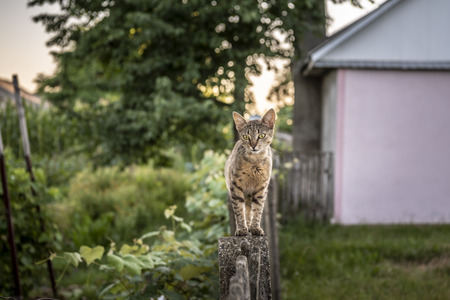Understanding Feline Hunting Instincts
If you’ve ever found a feathered or furry “gift” on your doorstep, you’re not alone—many UK cat owners experience this behaviour. To truly understand why our beloved moggies present us with prey, it’s important to explore their deeply ingrained hunting instincts. Cats are natural-born hunters, shaped by thousands of years of evolution. Even the most pampered house cat retains the primal drive to stalk, pounce, and capture. This instinct isn’t simply about hunger; instead, it reflects the feline’s ancestral roots as a solitary predator. Unlike dogs, who evolved alongside humans as social hunters and scavengers, cats have always relied on their own skills for survival. So, whether your cat is curled up by the radiator or prowling in the British countryside, that urge to hunt remains ever-present—regardless of how full their food bowl might be.
2. Why Do Cats Present Prey at Home?
Cats bringing home prey is a common sight for many UK pet owners, but what drives this behaviour from a psychological perspective? Understanding why our feline companions present their catch can deepen the bond between cats and humans, as well as help us interpret our pets needs more accurately.
The Psychology Behind the Behaviour
Domestic cats are instinctive hunters, even if they are well-fed at home. Their ancestors relied on hunting for survival, and those instincts remain strong. But why do they feel compelled to bring their prey back to the household?
| Psychological Reason | What It Means for Cats | Impact on Owners |
|---|---|---|
| Nurturing Instincts | Cats may see their human family as part of their social group and attempt to teach them hunting skills, similar to how mother cats teach kittens. | Owners might interpret this as a gift, though it is actually a sign of care or training behaviour. |
| Seeking Approval | Some cats look for validation from their humans, presenting prey as an achievement to be acknowledged. | This can be viewed as your cat seeking praise or attention, reinforcing your relationship. |
| Territorial Display | Bringing home prey demonstrates control over their territory and asserts their role within the household hierarchy. | This may show that your cat feels secure and confident in its environment, which is a positive sign for pet wellbeing. |
What This Means for You and Your Cat
For UK cat owners, understanding these motives helps you respond appropriately. Rather than reprimanding your cat, consider acknowledging the behaviour calmly. This reassures your cat that you recognise their efforts without encouraging unwanted hunting. Remember, while this act might not align with human sensibilities, it is deeply rooted in feline psychology and natural behaviour patterns.

3. British Wildlife and Domestic Cats
For cat owners across the UK, the impact of domestic cats on local wildlife is a subject of growing concern. Our beloved felines, while offering companionship, also possess strong hunting instincts inherited from their wild ancestors. When your cat brings home a mouse, bird, or even a frog, it is not only acting out natural behaviours but also interacting directly with Britain’s rich biodiversity.
Common prey species encountered by British cat owners include small mammals such as field mice and voles, various garden birds like robins and sparrows, and occasionally amphibians or insects. While these actions may seem harmless on an individual level, studies have shown that the cumulative effect of millions of pet cats can put significant pressure on local wildlife populations.
The Scale of the Issue in the UK
According to research by organisations such as the RSPB and Mammal Society, UK cats are estimated to kill tens of millions of birds and small mammals each year. This number does not account for those animals that escape but are injured or stressed by encounters with cats. The effect is particularly pronounced in suburban and rural areas where gardens offer prime hunting grounds.
Vulnerable Species
Certain bird species—such as house sparrows and song thrushes—have experienced population declines that may be partly attributed to predation by domestic cats. Similarly, the loss of hedgehogs in some regions has been linked to multiple environmental pressures, including cat predation.
What Can Cat Owners Do?
While it’s unrealistic—and unfair—to expect our cats to ignore their instincts entirely, British cat owners can take steps to minimise harm. Using collar-mounted bells, keeping cats indoors during peak wildlife activity hours (early mornings and evenings), and providing engaging indoor enrichment can help reduce hunting behaviour. By understanding both the evolutionary drives behind our pets’ actions and the unique challenges facing UK wildlife, we can act responsibly as both loving cat guardians and stewards of our environment.
4. Cultural Attitudes in the UK Towards Cats and Hunting
In the United Kingdom, cats hold a special place in many households, yet their instinct to hunt can evoke a range of reactions shaped by local culture and environment. Understanding these attitudes is crucial for cat owners who wish to respond appropriately when their feline friends bring home prey.
Urban vs Rural Perspectives
One key factor influencing British attitudes is whether an owner lives in an urban or rural setting. In cities and suburbs, wildlife diversity is lower, and the sight of a cat bringing in a bird or mouse may shock or distress owners more acutely. In contrast, rural communities often have a more pragmatic view, seeing hunting as part of a cat’s natural role, particularly for pest control.
| Setting | Common Attitude | Typical Owner Response |
|---|---|---|
| Urban | Concern for wildlife; preference for indoor cats | Discourage hunting; use collars with bells or keep cats indoors during peak wildlife hours |
| Rural | Tolerance or encouragement of hunting as pest management | Praise or indifference towards prey-presenting behaviour; allow free roaming |
The Influence of British Wildlife Conservation Efforts
The UK’s strong focus on protecting native species has also shaped owner behaviour. Campaigns by organisations such as the RSPB encourage cat owners to minimise predation on vulnerable birds and small mammals. This has led many urban dwellers to adopt preventative strategies, while rural attitudes often balance conservation with tradition.
Balancing Pet Welfare and Environmental Concerns
British pet owners frequently face a dilemma: how to respect their cat’s instincts while caring for the local ecosystem. Solutions commonly discussed in the UK include fitting cats with quick-release collars and bells, supervising outdoor time, and providing ample indoor stimulation to curb the hunting urge.
Cultural Nuances in Owner Reactions
Ultimately, how an owner responds to their cat’s prey-presenting behaviour reflects broader cultural values—ranging from affection and pride to concern and guilt. By considering both the local context and nationwide conservation goals, UK cat owners can make informed choices that honour both their pets and Britain’s cherished wildlife.
5. Guidance for UK Cat Owners
Understanding and Managing Hunting Behaviour Compassionately
As a UK cat owner, it is important to recognise that your cat’s instinct to hunt is deeply rooted in their evolution. While this behaviour may be unsettling, especially when they bring home prey, it’s essential to respond with patience and understanding. Never punish your cat for hunting; instead, focus on redirecting their energy in positive ways. Provide interactive play sessions using feather wands or laser pointers to mimic the thrill of the hunt. These activities not only satisfy your cat’s natural instincts but also strengthen your bond.
Tips for Minimising Wildlife Impact
Protecting local wildlife is a priority in the UK, particularly given concerns about declining bird populations. Consider fitting your cat with a quick-release collar and a bell, which can warn birds and small mammals of their approach. Keep your cat indoors during dawn and dusk when wildlife is most active. Alternatively, create a secure outdoor enclosure or ‘catio’ so your pet can enjoy fresh air without posing risks to native species. Regularly rotate toys to keep your cat mentally stimulated and less likely to seek out live prey.
Providing Enrichment Alternatives
Enrich your cat’s environment with puzzle feeders, climbing trees, and scratching posts. These additions encourage natural behaviours such as stalking and pouncing within safe boundaries. You might also introduce regular mealtimes with food-dispensing toys to engage their hunting instincts constructively.
Community Responsibility
Finally, communicate with neighbours and participate in local wildlife initiatives. Spaying or neutering your cat reduces roaming and aggressive territorial behaviour. By being proactive and compassionate, UK cat owners can balance their cats’ needs with respect for the country’s diverse wildlife.
6. Fostering Positive Cat–Owner Relationships
Understanding why your cat brings home prey is just the first step towards nurturing a harmonious relationship. While this behaviour may seem unsettling or inconvenient, it’s important to remember that it stems from natural instincts deeply rooted in feline evolution. As a responsible UK cat owner, you can employ several strategies to strengthen your bond with your cat while still respecting their innate behaviours.
Encourage Playful Hunting Indoors
One effective way to channel your cat’s hunting drive is by providing plenty of interactive toys. Feather wands, puzzle feeders, and laser pointers mimic the thrill of the chase and allow your cat to express their predatory instincts safely indoors. Rotating toys regularly keeps things fresh and engaging, helping prevent boredom-related behavioural issues.
Offer Enrichment and Stimulation
Cats thrive in stimulating environments. Consider setting up window perches so your cat can observe birds and wildlife from a safe distance. Scratching posts, climbing trees, and hideaways give them space to explore and exercise natural behaviours without causing harm to local wildlife.
Establish Consistent Routines
Cats are creatures of habit and appreciate predictable routines. Regular feeding times, scheduled play sessions, and calm bedtime rituals help build trust between you and your feline companion. This consistency reassures your cat and reinforces the feeling of security in their home environment.
Respect Their Instincts While Redirecting Behaviour
If your cat does bring home prey, avoid punishment or scolding—this can damage your bond. Instead, calmly remove the prey and redirect your cat’s energy towards approved activities, such as interactive play. Praising positive behaviours helps reinforce desirable actions while maintaining mutual respect.
Strengthen Communication
Pay close attention to your cat’s body language and vocalisations. Responding appropriately when they seek attention or comfort fosters a deeper understanding between you both. Gentle grooming sessions or quiet lap time can further enhance affection and trust.
Work Together for Wildlife Welfare
If you’re concerned about local wildlife, consider fitting your cat with a quick-release collar and bell to reduce hunting success rates. You might also keep them indoors during peak dawn and dusk hunting hours or use outdoor enclosures (catios) for safe exploration. These measures show care for both your pet and the UK’s treasured native species.
By focusing on enrichment, communication, and positive reinforcement, you’ll foster a loving relationship that honours both your cat’s nature and the unique joys of being a UK cat owner.


